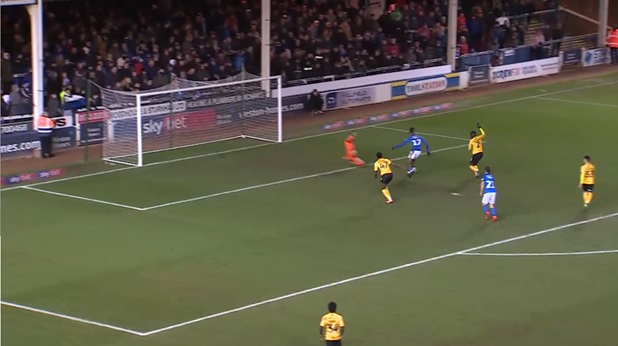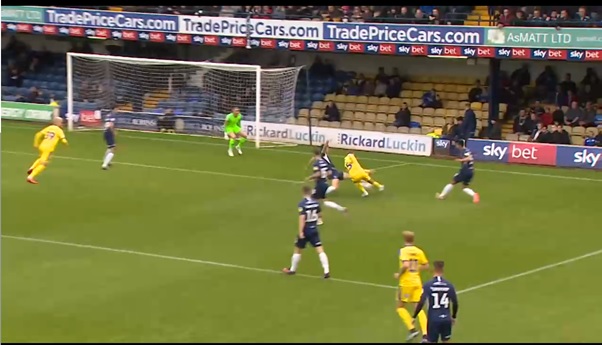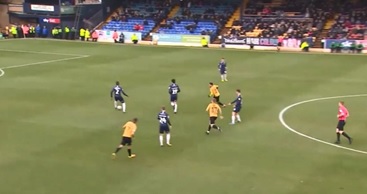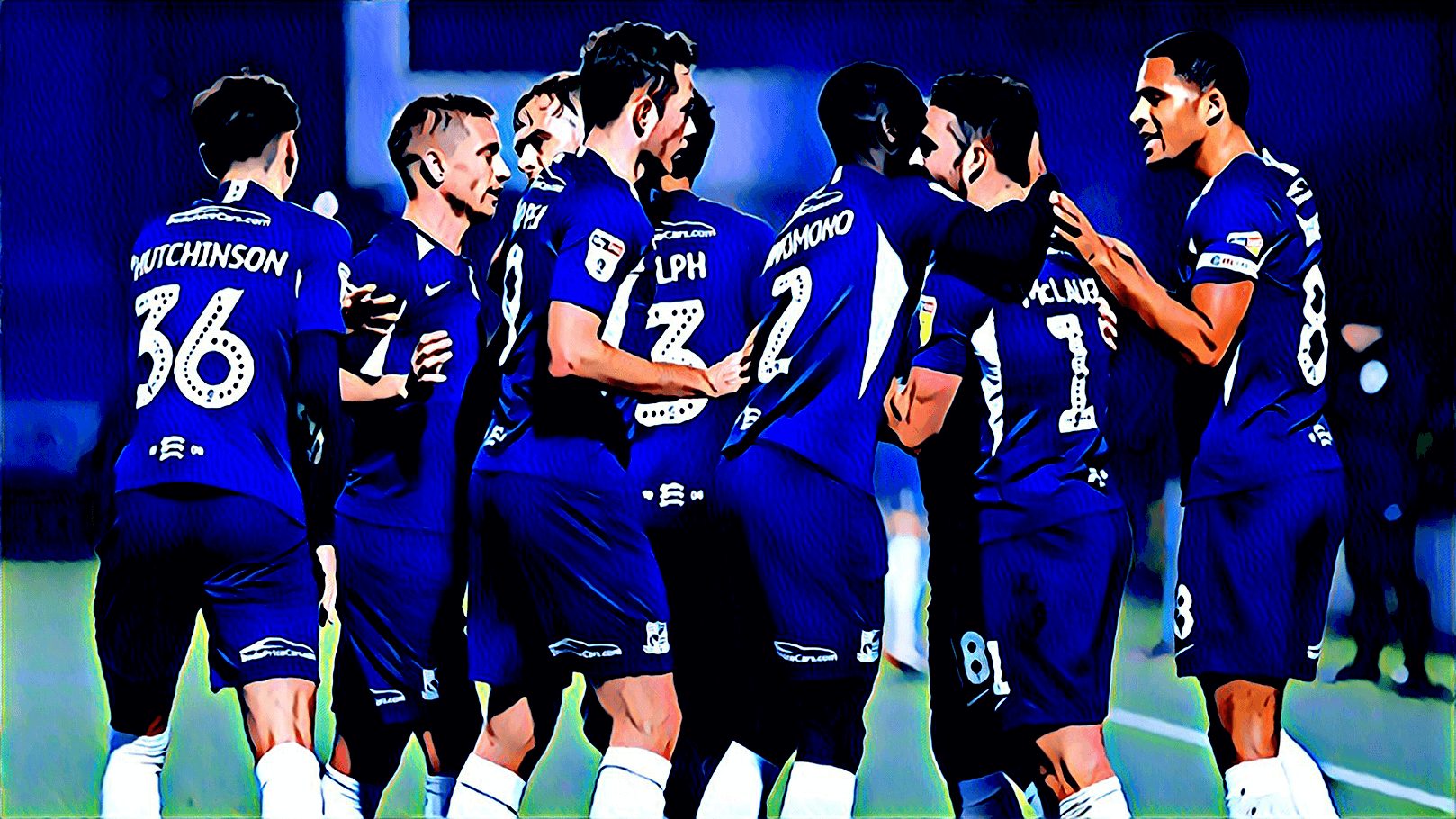Perry Littman conducts a focused analysis on Southend United’s defensive problems this season.
Sol Campbell, who previously managed Macclesfield Town from November 2018 to August 2019, has had a difficult season managing league one side Southend United. Campbell took over the Essex side after Kevin Bond resigned after a sixth consecutive league defeat at the start of the season. Former England international defender Campbell who had helped saved Macclesfield from relegation to non-league football, took over Southend on the 22nd October last year, watching his new side in the stands lose 7-1 to Doncaster Rovers, before taking charge for his first game in a 3-1 defeat at home to Ipswich Town.
Southend United, along with Bolton Wanderers, are at the bottom of the table and already far adrift. The shrimps have only won 4 games this season, two at home and two away. It is a completely different picture when comparing the league one table from this season to last year’s back in March for the 18/19 season. Thirteen teams (including Southend) were embroiled in a congested relegation struggle last season, where 12 to 22 was just separated by just six points. However, this season has been much clearer for the fate of both Southend and Bolton. Southend are 16 points off League One safety and have had off-field issues with players not being paid on time this season along with some unpaid tax bills.
The club had released and sold a number of experienced players in the January transfer window and was not able to replace them due to financial constraints. Names such as Simon Cox, Tom Hopper (Centre forwards) Rob Kiernan, Liam Ridgewell (Centre backs), and Nathan Bishop (Goalkeeper) had all left Southend.
This article will highlight Southend United’s defensive problems this season. Focusing on the goalkeeper’s body position and defensive errors that have led to the opposition scoring goals. A few images highlight the body position of the goalkeeper, often crouched too far down. Furthermore. The other images highlight defenders losing the ball in dangerous areas in their defensive third, which have led to them conceding many goals. The mistakes made by the Southend players are mostly down to lack of focus and concentration.
Image 1 shows a correlation chart of all league one clubs this season, showing the relationship between opposition shots on target vs Goals conceded. Southend (in the red circle) are the outlier in the chart. Southend has conceded 85 goals this season. The most in all of the top 4 English leagues. In the 35 games played by this season, the ‘Shrimpers’ on average faced 5.43 shots on target a game from the opposition, 2.43 of them ended up as goals conceded, as against a predicted value of 1.86. Only Bolton faced more shots than Southend (5.50 on target) but conceding 1.94 goals at a prediction of 1.89.

Image 1. Correlation chart is taken from Footcharts showing Opposition shots on target vs. Goals conceded. Note that this diagram does not take into account the quality of shots and how far the shot was taken from the goal.
Southend’s poor defensive performance has been to the club’s detriment with mistakes costing them points in most games. The team are conceding far too many goals per game (2.43) compared to the league average this season.
Goalkeeping Problems
Southend’s problems in goal have started with a lack of stability. Mark Oxley, who was voted Fans and Players’ Player of the season for the 2017-2018 season, keeping 17 clean sheets, has struggled this season, finding himself on the bench or recovering from injury in recent games. Nathan Bishop left Southend United and signed for Manchester United on 31st January this year for an undisclosed fee on a two- and half-year contract.
As shown in images 2 and 3, we can see the goalkeepers attempting to stop the ball but are unsuccessful in their attempts. In Image 2, we see the goalkeeper rushing in to stop the ball with his feet. Remaining patient instead of fully committing himself would have been a much better method.
Image 3 shows former keeper Bishop coming out in a one v one situation. Although he does not commit himself as ‘wildly’ as in image 2, his approach, in terms of his body stance, still needs adjusting. His upper back is far too crouched down to his waist level. Although this can help Bishop to dive to either side more quickly, it makes it easier for the Bolton striker to just chip the ball over his head.

Image 2. Against Peterborough (Away). Peterborough gets the ball back into the box, and their striker is one on one with Southend goalkeeper Mark Oxley. The keeper commits himself too early, attempting to stop the ball with his feet. Striker Ivan Toney (17) takes an extra touch with the ball and takes it around the keeper on the floor.

Image 3. Against Bolton (Away). Ex-Southend Goalkeeper Bishop, in a 1 v 1, has to come out further to stop the ball. He does not spread himself out, neither making himself big until the ball has passed him. He is far to crouched down with his hands, too far close to the ground, and not in an athletic or strong position.

Image 4. Goalkeeping body position (Coaching Young Goalkeepers Part 1; Set Position, ‘W’ and ‘Scoop’ Technique, 2014).
Image 4 shows an example of how a Goalkeeper should position their bodies to help prevent goals. The hands, knees, and feet should be relatively parallel with each other. And the Goalkeepers’ body weight should be forward with bent knees with the hands at waist height. The thing that sticks out is the upper body is upright and straight, unlike the Southend Images.
Goalkeepers at the near post

Image 5. At home, again the keeper sees the ball enter the goal into the far low corner.
Southend keepers have conceded goals at their near post. Debate can be argued that a goalkeeper should never be beaten at his near post. Some strikes such as Giggs v Seaman (1999) are just too unstoppable with lightning pace and the right height would trouble any keeper. Image 5 however has the keeper struggling to cope with a low strike with not a lot of pace put on it. He struggles because of a failure to adopt the right body position to start with.
Figure 6 shows Southend conceding the winning goal that knocked them out of this season FA cup. The strike is really good, hit with enough pace and the right amount of height to beat the keeper at the near post. Analysing the image more closely though, we can see the keeper bent too far down to begin with.

Figure 6. Against Dover (Cup, Away). Ex Southend Goalkeeper Bishop is at the near post and gets beat as the ball passes him into the far top corner. The starting position of the upper back is too low to begin with.

Figure 7. An example of Manchester United’s David De Gea performing the block save at the near post against Tottenham. With one knee up and the trailing knee tucked away. His upper body is also much more upright compared to the Southend examples.
Getting the basic goalkeeping fundamentals correct could help prevent the high amount of goals being conceded. A good body shape will help allow the keeper to be more fluid and exact in terms of decision making.
Defensive errors leading to goals
Today’s centre backs are expected to be more skilful on the ball. They need to be able to start the attack. At the same time, forwards are applying more pressure and mark them more tightly in an effort to win the ball in a dangerous area of the field. The images below show Southend defenders losing the ball in their defensive third. The opposition has taken advantage by regaining possession and scoring a goal. The images highlight defenders losing concentration and not coping with the pressure, which leads to players losing their footing, and just giving the ball away to the opponents, often gifting it to them to their feet with no players around them. The ability to deliver the right pass is key to any team, but to pass the ball to the opposing team in a dangerous area can be catastrophic as Southend have experienced.


Figure 8. Defender Elvis Bwomono in possession of the ball against Bristol Rovers, loses his foot and falls over with no one around him applying pressure. Rovers midfielder Rollin Menayese (27) pick up the loose ball and score from the counter-attack.

Figure 9. Southend are playing out from the back against Burton Albion. The centre-back attempts to pass the ball to his partner in defence, but his ball is quickly intercepted by the striker who then passes to his fellow striker to score.
The aim of playing out from the back is to progress with the ball up the field with clear passes even under pressure. The intention is to overplay opponents to then create promising attacking situations higher up the pitch. The idea is to allow players to make decisions and dictate where the ball goes. Southend United will attempt to play out from the back, but often lose the ball too easily. Southend have players in the right places at the right time with passing lanes being kept open. But the team lack positional awareness and discipline especially when on the ball. They struggle with touch, anticipation, vision and the ability to pass the ball.
The team continue to play out from the back despite making mistakes. Booting the ball up the field has no way of predicting or controlling the outcome. Another advantage of playing out from the back is that the other team will have to push up higher in an attempt to win the ball, having to work harder which could lead them to become more tired in the later periods of the game.
Southend United’s last game was played back on Saturday, 7th March, in a 3-1 win at home against Bristol Rovers. Sol Campbell’s Southend ended a run of six successive defeats with a committed display in a well-deserved win. They’ll need several ore performances of that ilk if they are to keep their place in the division.
- Penalty kicks: A literature review - June 19, 2020
- Analysis: Why have Southend United struggled in defence? - June 4, 2020
- Hipster Guide 2016-17 : West Ham United’s tactics, key players, and emerging talents - August 11, 2016
























































